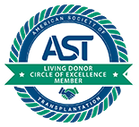LIVING DONATION
Living donation is the way the medical profession refers to donating an organ to someone in need while the donor is living. Living donors may donate a kidney, a part of the liver and in some rare cases, a portion of the pancreas, intestine and a lung. Even better, kidney and liver patients who are able to receive a living donor transplant can receive the best quality organ much sooner, often in less than a year.
FACTS:
• Living donation and transplantation was developed as a direct result of the critical shortage of deceased donors.
• Living donation is an opportunity to save a life while you are still living.
• Living donation is not covered by your donor registration and must be considered personally and discussed directly with a transplant
center.
• Today, one in four living donors are not biologically related to the recipient.
• Living donation offers an alternative for individuals awaiting transplantation from a deceased donor and increases the existing organ
supply, saving more lives.
• Living donation is an opportunity to save a life while you are still living.
• Living donation is not covered by your donor registration and must be considered personally and discussed directly with a transplant
center.
• Today, one in four living donors are not biologically related to the recipient.
• Living donation offers an alternative for individuals awaiting transplantation from a deceased donor and increases the existing organ
supply, saving more lives.
THE NEED:
• More than 105,000 men, women and children await lifesaving organ transplants.
• 82% of patients waiting are in need of a kidney.
• 13% of patients waiting are in need of a liver.
• A living donor is an option for patients who otherwise may face a lengthy wait for an organ from a deceased donor.
• To spare an individual a long and uncertain wait, relatives, loved ones, friends and even individuals who wish to remain anonymous
may serve as living donors.
• 82% of patients waiting are in need of a kidney.
• 13% of patients waiting are in need of a liver.
• A living donor is an option for patients who otherwise may face a lengthy wait for an organ from a deceased donor.
• To spare an individual a long and uncertain wait, relatives, loved ones, friends and even individuals who wish to remain anonymous
may serve as living donors.
HOW TO START THE PROCESS:
To help someone through living donation, talk to them and the transplant program where the person is listed. To be a non-directed living donor, contact a transplant center to find out if they have this type of donation program.
OU - Oklahoma Transplant Center
St. John Transplant Center
Integris Nazih Zuhdi Transplant Institute
For more information on becoming a living kidney donor, contact the National Kidney Donation Organization.
OU - Oklahoma Transplant Center
St. John Transplant Center
Integris Nazih Zuhdi Transplant Institute
For more information on becoming a living kidney donor, contact the National Kidney Donation Organization.








